Positive Health Online
Your Country

From Bonesetter to Bowen: Exploration of the Therapy Inspired by Tom Bowen
listed in bowen technique, originally published in issue 194 - May 2012
Personal Introduction
I claim that esoteric events brought me into contact with the Bowen world, for in 1995 I was introduced to 'Patricia' in a New Forest pub. Within minutes she was sitting on my knee with a pint, as we discussed spiritual healing. Next item was "Have you heard of the Bowen Technique, and would you like a treatment?" The answers were "No", and "At your hands - yes, please!" Sadly closing time put the stoppers on that one, but a seed had been sown ..... and setting to one side my teacher training course (Steiner based) I soon put my head, heart and hands to a new adventure in life: a very intensive four-day Bowen course in Somerset.
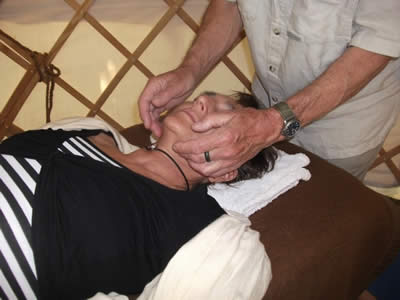
NST 'temporo-mandibular (TMJ) procedure'.
Plunging in at the deep end, this complete novice to bodyworker was mesmerized, not only by the hilarious and very effective teaching by Julian Baker,[1] but by the stupendous depth and range of the therapy. There was no manual available, but "You are welcome to take notes ..... in fact that would probably be helpful to you".
What is Bowen Therapy?
Bowen is a hands-on therapy, involving gentle rolling movements over muscles and tendons at precise points on the body, non-invasive and suitable for any ages. Technically a number of these points coincide with the body's 'meridian system', but not being an acupuncturist I can't comment further! There are also comparisons with cranio-sacral therapy, fascial release and maybe lymphatic drainage work. Then pundits talk about muscle spindles, golgi tendons and the 'piezo-electric effect'. But, put very simply, it is a cross-fibre muscle-rolling technique.
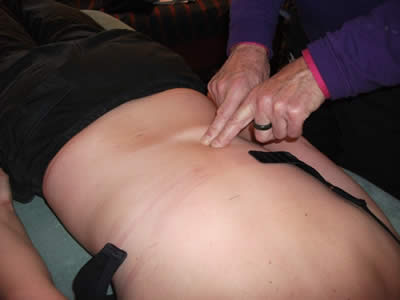
An answer to back problems: NST/Bowen work on 'erecta spinae' muscles.
It seems that this process releases energy, sending impulses to the brain to trigger the body's own healing systems. Hence a Bowen practitioner is seen to be a catalyst, setting in motion a process of self-healing, or 'auto-regulation'. This is appropriate for babies as much as for 'seniors' or fitness addicts, and because a Bowen treatment affects the whole person, not just bits, it is referred to as a 'holistic' therapy. If what I call the 'core twenty minute treatment' is repeated three times over in three weeks, is said to resolve 60%-70% of symptoms with which clients have presented.[2] Then there is a great big box of add-on moves to suit more specific individual needs. In practice all I do is to use my fingers and thumbs to find the specific points on a client's body, create a bit of pressure against a muscle, and then slowly roll over it with a 'plop'! It sounds simple enough but this can have a really powerful effect. Just occasionally some discomfort may be created, but short lived if at all.
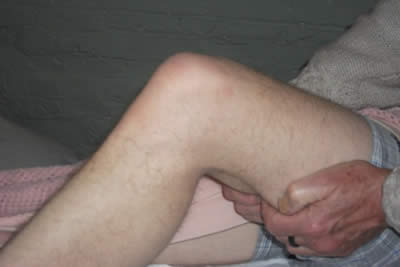
NST/Bowen treatment to relieve sore hamstrings and knees.
What about clothing? I'd say that it is preferable but not essential, and that loose, lightweight clothing is a good option, except for certain of the 'moves' which are far more effective with direct skin contact (i.e. shoulder treatment). I have worked through reinforced jeans, layers of silk underwear, and even a plaster cast ...... still effectively, although I recall one of my teachers saying: "The less clothing the greater the effect, so you can tell your clients that to get their full money's worth, strip right down!"
Proof of the Pudding, and Personal Stats
Some of the early demos that I witnessed were just astonishing: frozen shoulders becoming 'unfrozen', back and neck pain relieved within minutes, and in one case during a demonstration of some head-and-eye-work a young lady suddenly crying out to the tutor in astonishment, with tears of joy: "Ozzie, I can see you" (a few moments before, she had been unable to do so without glasses!).[3]
After the four day initial training I laid my hands on any friends in need of repair. Danny lost his indigestion, and his mother's head, which had been tilted over on side since an earlier stroke, straightened up. I well remember her cry of excitement, in a strong Scottish accent, when Danny sent her out to see herself in the mirror: "Danny, Danny, ma heid ..... it's streit agin!"
Then 5-year old Sammy ceased having life-threatening breathing problems, Rupert lost his shin splints in two sessions, Ruby's panic attacks were resolved, and I was just over the moon. I have had testimonials such as:
"Mark (aged 49) is so chuffed. He says it's the first time he's ever had a therapy that's had any effect, and it's the first time since he can remember that his body felt straight and he hasn't been in agony when he first gets up in the morning and walks down the stairs."
(Frome, UK. 2010)
and
"Since having a treatment with you I feel much more energetic and also able to express myself authentically which has improved my work and is having an impact on my personal relationships as well. It's re-inspired me to carry on with my healing and explore other avenues as well ....."
(Glastonbury, UK. 2011)
Some years ago my (detailed) records for treatments given showed 90% of the clients reported improvements, and that 60% of those were 'good-to-excellent'. For the record, the age range treated was from 12 to 96, and about four sessions were needed. Those clients were complaining of problems such as frozen shoulder, bad back, tennis elbow, fibromyalgia, pulled hamstring, whiplash, anxiety and migraines. How come such a wide range of 'challenges'? Because NST and Bowen do not treat the problem. They treat the person..... holistically, remember?
'Possible' Origins
As for the origins of this modality, apparently some gifted Australian healer, a member of the Salvation Army, had just sort of pulled it out of a hat. However, at the time of first training, my head was swimming with so much new information that the question of origin was unimportant. Keeping up-to-date with early editions of Bowen's Hands,[4] I noted the regularly published little quotes indicating that Tom Bowen (1916-1982) considered it "a gift from God".
Then there was the story told by Oswald Rentsch about 'Jack' who fell out of a top floor window on to the concrete, and ..... "as soon as Mr Bowen's hands were on me, I felt no more pain".[5] So it seemed this healing gift may have been seriously God-given. I certainly 'sold' these aspects to the rather suspicious Salvation Army chief in Gloucester, and then promptly treated, successfully, his wife and a few friends!
Oswald Rentsch[6] is an Australian massage therapist and farmer who used to use the letters DO for the questionable title of Osteopath. He is a charismatic flamboyant character now over 80, better known as Ozzie, who has tirelessly and impressively toured the globe teaching Bowen together with his wife Elaine, a focussed, driving force. Together they are primarily responsible for the remarkable spread of Bowen therapy since the mid 1980s, following his promise to Mr Bowen that "I would make his name known across the world". True missionary zeal!
Schisms and Crises (For abbreviations see notes at end)
As the Bowen 'product' developed internationally, schisms and power struggles also manifested in the Bowen world. Ozzie's mantra of "Keep it pure, keep it original" was challenged, when first Stuart Rappaport, and later Jock Ruddock, came on the scene in England, teaching their own versions of Bowen ..... There were mutterings of "How dare they .... we will be suing!" Parallel events were taking place in Australia, where, by some slip of the pen 'An Interpretation by Oswald Rentsch' had become 'The Original Bowen Technique'.[7]
A tussle for supremacy developed between Julian Baker ECBS[8] in the UK, and the Australian funded BTAA,[9] both asserting that they were the rightful purveyors of 'The Bowen Technique' - despite teaching an identical format. That friction still continues today, but in a less hostile form. Also around then the BTAA launched its new look with the name of Bowtech. As UK Bowen practitioners became frustrated with this bickering, an independent Bowen association, BTER,[10] was set up in the UK to promote this new therapy as whole, and to act on behalf of all Bowen therapists. That ran well for a few years until someone absconded with funds!
It was re-constituted with proper safeguards, and has recently been renamed BTPA.[11] NST (NeuroStructural Integration Technique) arrived in Britain in 1998 with an 'interpretation of Bowen's later work', kind of suggesting that what had been taught so far was not really up-to-date. Also very refreshing about NST was an open-minded rationale and a creative ability to address individual situations. And with time, other variants of Bowen's work have popped up, mostly taught by itinerant Australians, riding on the back of the successful spread of the Bowen Technique.
Schisms create crisis, and they also create new directions.
Informed 'Boweners' looked for the real origins of Tom's work, having as their starting point that his father had seemingly emigrated from Wolverhampton in England to Australia, and that Tom, born in Australia, was a manual worker, was interested in sports, sports clubs and swimming, developed some kind of bodywork initially born out of long discussions with a masseur called Ernie Saunders, then got going on his own having a clinic in Geelong, was assessed by a government commission to be giving upward of 13,000 treatments annually, had a 'success' rate of about 90%, allowed a few people to watch him work but trained only the 'six boys' to any depth of understanding, was a very caring man possibly a diabetic. After a leg amputation he died of infection in hospital. That's the bare bones.
So lets take those bare bones and re-set some of them.
'Bonesetting'
Wikipedia quotes: "A bonesetter is a practitioner of joint manipulation. Before the advent of chiropractors, osteopaths and physical therapists, bonesetter were the main providers of this type of treatment. Bonesetters would also reduce joint dislocations, and re-set bone fractures."
A 16th century friar, Thomas Moulton wrote a document named The Compleat Bonesetter, and apparently bonesetting was common practice in many homes. It is even said that bonesetters provided free health care in the Middle Ages!
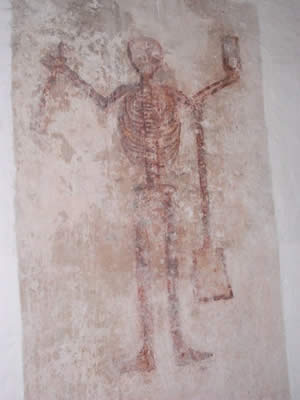
Church painting: "The backbone's connected to the rib bone". Forerunner of tensegrity!
This talent, gift, art, or science is often passed down through generations of a family, but tends to run underground these days due to 'Health and Safety' considerations, potential litigation, and (often) disbelief. Indeed, in my own area of Worcester-Hereford the tradition of bonesetting is still alive, being common in 'folk medicine' perhaps thirty years ago. The Bywater family were well known for it, and were 'paid in buttons' (Johnny's waistcoat had many silver buttons down the front!), and Eddie Drew lived in an old railway carriage and would work on those who came to see him in pain, or the injured sheep that the farmers would bring in to him.
In Australia in 1845, Johan Scholz who had been bonesetter to the Prussian army, set up a practice in South Australia, which continued through the next three family generations; and Ernie Saunders, the most famous 'masseur and bone manipulator' in Australia and beyond, lived from 1880 to 1951. For many footballers Saunders was a God, and like all football 'trainers' he would have used a variety of methods, including specific ideas learned in America for injury treatment. (He would run on to a football ground to treat an injury, saying "I like to catch them hot.") Without his services, the famed cricketers Sir Don Bradman and Ray Lindwall would have faced much shorter careers.
Ernie it seems passed much of his knowledge to Tom Bowen, and he was certainly the person who showed Tom the essentials of a very new way of working. And where did Ernie learn his knowledge? Well, it seems that he went with Les Dettman a manual therapist, and a third, unrecorded person to attend a Japanese pressure point course in America. That would have been before the second war, so in the 1930s. He was also well travelled in the world, and would have had opportunity to gain knowledge elsewhere, as well as being a natural healer.
"The most important bodyworkers of the immediate post-war period to the early 80s in Victoria, Ernie Saunders and his son George, Les Dettman, Bill Mitchell, Tom Bowen, and others, had no formal training. They didn't need it. They were healers."[7]

Tom Bowen
Some Difficult Times
After leaving school Bowen started at the local Geelong textile mill, moved on to being a milk carter within a few years, and sometimes worked as a carpenter - a jack of all trades, a very likeable and sensitive young man, and an excellent swimmer.
In 1941 Tom, aged 25, was married to Jessie, maybe still having no solid income basis, but having worked around football clubs and some masseurs and manipulators. He was back at the mills in 1953, in 1955 moved to the cement works ('Loco cleaner', then 'Blacksmith's striker'), and in 1957 he started formal bodywork, working part-time from the home of his former colleague Stan Horwood and wife Rene.
Then occurred a little known event: Tom Bowen had some kind of a '(nervous?) breakdown', with one month time-off-work in 1959. It could have been due to hand-to-mouth living, a heavy handed father in his earlier upbringing, family pressures including his sister-in-law Lillian living full-time with the family, disappointment in life with not living to the potential of his true abilities, or some combination.
As detailed in Col Murray's book,[7] Tom's son Barry explained: "I was brought up in a household totally controlled by women ..... and the father never came home ..... well I hated it." His father was: "Controlled by all those women, and not really ever given the chance, you know, no encouragement. I think he was really a free spirit and that he was really caged".
These would also have been factors in setting him towards a recognised drinking habit.
With Rene's motivation (Stan had died 1957) Tom Bowen started in full time bodywork in 1961. Like other bodyworkers he made his name working with sports clubs, and his popularity extended from football to athletics, rowing to running, and of course swimming, with comments recorded such as:
"Overwhelming, and appreciated by many ..."
"He would never charge any of our players or myself, or anything like that",
"....my sciatic nerve ..... and he'd fix it. All he'd do was wiggle, wiggle, push ..... it was really interesting".[7]
Every month he held free sessions for children with disabilities, and on Saturday evenings the clinic was not closed 'until the last injured footballer had gone home'.
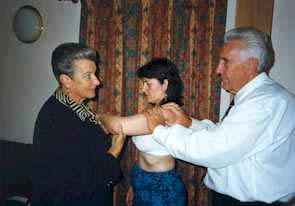
Ossie and Elaine Rentsch: The Shoulder Procedure
originally published in Positive Health PH Online Issue 44 - September 1999 -
www.positivehealth.com/article/bowen-technique/gentle-touch-bowen-therapy
The Bowen Apprentices ..... Six 'boys' and a 'gal'[7]
TB cannot have been an easy man to learn from. He preferred to teach by the 'apprenticeship' system, allowing a number of practitioners to watch him for a half day or day but only a few to spend greater lengths of time. "People come here until either they get sick of me or I get sick of them because they don't know what they are doing ...."[7] There was a time when he is reported to have said "I've shown you 10% of what there is" ..... and the rest went to the grave with him. I suppose that gives hope for us practitioners who have a chance to develop the next 90%!
- As Romney Smeeton said: "He never taught us ..... only allowed us to observe".
- Keith Davis (chiropractor) said he could understand a patient's issue "just by observation. He didn't inspect much ..... he'd grunt, do something and off he'd go".
- Ozzy Rentsch (massage) was to come to his clinic 'next Wednesday morning'. After observing for two days he said: "Mr Bowen, I can't make head nor tail of what you are doing ..... I am going home". 'He took me aside, and explained. After that I worked with him (or observed?) for two and a half years'.[8]
- Kevin Neave (also a chiropractor) found it very fascinating. "Tom had no academic knowledge whatever, just feel and appreciation".
- Maureen Alexander seems to have observed him for around two years. As she first walked towards him in the corridor he said: "Oh you've got a right lumbar region ...... and a right ovary problem". "Without even laying me down, he'd picked it quite spot on!"
- Another chiropractor Nigel Love observed Tom for a substantial time, but did not live long enough to see Bowen inspired therapy extend worldwide as it has.
- Kevin Ryan was an osteopath, and was with Tom only in the last couple of years of his life at the clinic - so that would be around the time 'the first leg came off'. Some creative new moves had to be developed with Tom working from a wheelchair at times. Kevin is smart, had done a lot of training in different therapies, and seems to have been well trusted by TB; he reckons that he has a grasp of at least 15% (tongue in cheek?) of what TB knew, and he still teaches his own version of 'Mr Bowen's therapy'.
The Webb Commission
The Victorian Government Committee into Osteopathy, Chiropractic and Naturopathy came to Geelong in 1973 to interview practitioners with the aim of according official status to those who were accepted. TB had applied under the category of 'osteopath'. In his interview he said that he was self-taught, and that previously he had been a labourer but that "different ones were coming to me for massage and what not". He indicated that the Department of Health had no problem with him doing massage at the football clubs, where he had learned from watching others working. He agreed that he had no qualifications, and had left school in the 8th grade.
He also explained that his method of treatment was: "through my fingers and nerve pressure ..... I get the vibration from the nerve ..... mostly (in) the back and the neck ..... You go for the nerve pressure on the sacroiliac. One finds that the sciatic nerve jumps, and you go for it".
Footballers' problems? "mostly ligaments of the knee ..... a cartilage is a doctor's job ..... dislocations are not in my line".
The Commission estimated that he was giving around 13,000 treatments annually, or maybe as much as 16,000, which means around 300 sessions per week. Allowing Sundays off and 20 on every Saturday, that's between 50 and 60 a day the rest of the time, working single handedly!
Interestingly Kevin Neave once said "The most I ever did in one day was 72 patients and I was slaving there till late at night, very late."
Well, the Commission did not grant TB the official status that he so desired. Had he spoken in more detail about his interaction with the legendary Ernie Saunders, and had explained more clearly to the Commission what he was doing in his treatments, things might have turned out differently. They probably wanted to find out if he knew what he was doing, but without academic knowledge, he was unable to put it into words. Tom Bowen always let his hands do the talking, and sadly that was not enough for a Government Commission.
This must have been yet another disappointment in his life, which perhaps made him feel that his work was not being taken seriously. However, four years after his death, Ozzy started to teach his own interpretation of what he had 'observed', and 25 years down the track, Bowen work has branched out and flowered in many countries.
Developments, Training and Courses
Each time that a crisis or schism has occurred in the Bowen world it seems that a new variant of the 'technique' has sprouted! The mantra of "Keep it pure, keep it original" has itself been a casualty of this process, and interpretations of Bowen therapy have developed in several countries. These include Bowtech, ECBS and NST, as already mentioned, then also ISBT from Australia (Col Murray), Neural Touch from the USA (Gene Dobkin) and Fascial Bowen from Wales (Howard Plummer). Then there's Ross Emmett of Australia who has come out with his own stuff, which also shares the 'cross-fibre' approach.
Current trends encourage that any therapy be taught in courses and modules with officially 'recognized' certificates at each step of the journey, and hence the variants of 'Mr Bowen's Therapy' are now taught as a sequence of modules with the requirements of 'box ticking' in mind. It is a package deal! Yes, the old apprenticeship system is still fully justified, but is simply not appropriate for most modern would-be practitioners.
Not until the more 'advanced courses' (of any of the interpretations), where some latitude and discretion may be encouraged can we get a glimpse of pure Bowen work.
And what is 'pure Bowen work'? How about these challenging reminders:
"He didn't inspect much ..... he'd grunt, do something and off he'd go",
or
"All he'd do was wiggle, wiggle, push ....."
Teaching the Magic
Learning NST was for me a refreshing development from The Bowen Technique, with its underlying rationale and philosophy. In practice the treatments seemed to flow more smoothly, I could apply it to a wider range of 'problem areas', and best of all I get great results using it. The boss, Michael Nixon-Livy is approachable with a very wide range of therapy experience, and in answer to "Why do we do it this way?" there is a reasoned response, instead of: "Because that's how Mr Bowen did it". He also talks about balancing the cranio-sacral rhythm, uses kinesiology, and enthuses about 'tensegrity', the principle developed by Buckminster Fuller!
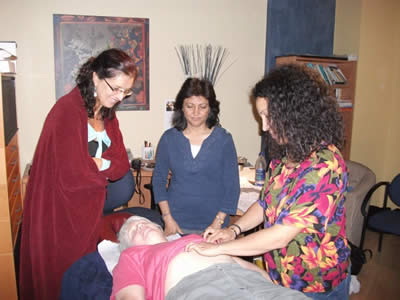
Introductory NST course in Vancouver, 2011.
As a certified teacher, I am committed to helping others to learn this 'magic', and I am thrilled to be teaching the Introductory NST course, despite the inevitable package dealership, You can find me doing so wherever I am invited. That has included Malvern, Greece and Vancouver in 2011. Plans for 2012 are similar, with the additional inclusion of New Zealand. I shall welcome your company at any of these courses, and especially recommend a week at the Kalikalos Centre in June (Pelion peninsular, Greece) since this is residential and includes plenty of beach work, swimming and relaxing. Do join us!
Notes and References
1. Julian Baker was the second person to teach Bowen (BTAA format) in the UK. He assisted Isy Saunders (now Isy Gabriel) to run the first course in 1993. Julian founded the ECBS: The European College of Bowen Studies.
2. Comment by Ozzie Rentsch at workshops I attended, 1996-98.
3. Witnessed at workshop taught by Ozzie in 1998(?).
4. Bowen's Hands was a journal produced by the BTAA. It no longer exists.
5. This incident told to UK radio's 'Derek Jamieson Show' about 1994.
6. Oswald Rentsch is better known to the Bowen world as 'Ossie'. I have written it as 'Ozzie' because that's how it sounds!
7. In Search of Tom Bowen ..... and the therapy he inspired by Col Murray: ISBN 978-0-646-53115-1.
8. ECBS: see 1 above.
9. BTAA: Bowen Therapy Academy of Australia
10. BTER: Bowen Therapists' European Register
11. BTPA: Bowen Therapy Professional Association
Further Information
1. 'The World of Bowen' is a one-day workshop in which I offer participants an overview of the Bowen approach, as well as a treatment and some hands-on experience. A perfect start for enquiring minds, as well as offering 7 hours CPD.
2. 'Beyond Bowen: Dynamic Body Realignment' is my name for the official NST Introductory Course, over two days. This allows a novice to learn a simple and effective hands-on treatment to give to friends and family, and is also an essential starting point for a non-Bowener to take the full NST training. 14 hours CPD.
For More Information
Go to www.thebowenman.co.uk , or Facebook 'The Bowen Man'.
Alternatively please come visit me in Malvern, or invite me to your group!
For information on NST go to www.nsthealth.com
For about Kalikalos in Greece go to www.kalikalos.com
Acknowledgment, and Final Plug!
This piece has been put together as a result of my personal experiences, from formal instructors, colleagues and many of my clients. I wish to acknowledge all those who have 'helped me on the Bowen Road', in whatever way. Doubtless some readers will take issue with certain of my comments and 'facts', but it is not my intention to cause offence. I have tried to stick to the truth that I have experienced, and so my apologies to anyone who does feel offended.
My most recent source of information has been a much needed book published in 2010 by Col Murray of ISBT (International School of Bowen Therapy): In Search of Tom Bowen .... and the Therapy he Inspired, containing extensively researched background material on Tom Bowen. An important piece of work, a good read, and a major step in understanding the man and his attributes. I have lifted some of the information and quotations in this article directly from his book. No apologies - they are good ones.
Comments:
-
No Article Comments available